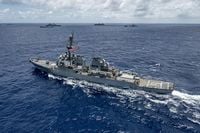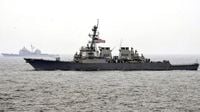On Wednesday, July 23, 2025, tensions flared in the Gulf of Oman as an Iranian navy helicopter confronted the U.S. Navy destroyer USS Fitzgerald, marking the first direct encounter between Iranian and American forces since the recent 12-day conflict between Iran and Israel.
According to Iranian state television, the incident unfolded around 10 a.m. local time when the USS Fitzgerald approached waters claimed by Tehran under Iranian supervision. In response, Iran dispatched an SH-3 "Sea King" helicopter that flew directly over the U.S. warship, issuing a stern warning to maintain distance from Iranian territorial waters. The Iranian pilot reportedly urged the destroyer to "change course," a warning that, according to Tehran, the U.S. vessel ultimately heeded by retreating southward.
The exchange was described by Iranian media as tense and confrontational. The U.S. destroyer allegedly threatened to target the Iranian helicopter if it did not vacate the area, but the Iranian air defense forces declared that the helicopter was under the full protection of Iran's integrated air defense system. This protection underscored Iran’s commitment to asserting its territorial claims in the strategically vital Gulf of Oman.
Video footage released by Iranian state media showed the helicopter hovering close to the USS Fitzgerald, with audio capturing the Iranian crew member's radio warning in English to the U.S. ship. The images and video provided a rare glimpse into the high-stakes naval standoff, emphasizing the seriousness with which Iran views incursions near its waters.
However, the U.S. Central Command and a U.S. defense official offered a markedly different account of the incident. The official, speaking anonymously, characterized the interaction as "safe and professional," emphasizing that the USS Fitzgerald was operating in international waters and that the incident had "no impact" on the ship's mission. The official dismissed claims of heightened tension as "falsehoods and attempts by Iran’s Islamic Revolutionary Guard Corps to spread misinformation."
This confrontation comes amid a backdrop of escalating hostilities between the United States and Iran. Just a month earlier, during the 12-day war between Israel and Iran, U.S. B-52 bombers targeted three key Iranian nuclear sites in an effort to cripple Tehran's uranium enrichment capabilities. While U.S. President Donald Trump hailed the strikes as a "spectacular" success that "obliterated" Iran’s nuclear program, intelligence reports suggested only partial damage, with some facilities reportedly remaining operational.
Following those strikes, Iran threatened to close the Strait of Hormuz, a critical chokepoint through which roughly a fifth of the world’s oil and gas trade passes. Such a move would have sent energy prices soaring and severely disrupted global markets. Iran’s strategic position along the Persian Gulf, the Strait of Hormuz, and the Gulf of Oman gives it significant leverage over vital shipping routes, a fact that Western powers, including the U.S. and European Union, monitor closely with naval patrols to deter any aggressive moves.
In the days following the confrontation, Iranian President Masoud Pezeshkian stated in an interview that Tehran remains committed to its nuclear program for peaceful purposes and is prepared for any future conflict Israel might wage against it. He expressed skepticism about the prospects for a ceasefire between the countries, signaling a continued atmosphere of tension.
Meanwhile, Iran's lead nuclear negotiator, Kazem Gharibabadi, warned that Tehran might withdraw from the Treaty on the Non-Proliferation of Nuclear Weapons if European powers reinstate international sanctions. This statement came ahead of planned talks in Turkey with representatives from France, Germany, and the United Kingdom. Although the United States withdrew from the 2015 Joint Comprehensive Plan of Action (JCPOA) in 2018, the European signatories remain committed to the deal and have threatened to reimpose sanctions if an agreement is not reached by the end of August.
The July 23 incident is not the first time Iranian forces have confronted U.S. naval vessels near their southern coast. In 2023, Tehran claimed it forced a U.S. submarine to surface while crossing the strategic Strait of Hormuz, a claim the U.S. denied. These recurring encounters underscore the fragile and often volatile nature of U.S.-Iran relations in one of the world's most geopolitically sensitive maritime regions.
As of the latest reports, the U.S. Navy has deferred detailed comments to the U.S. Central Command, which promised to provide a response either later on July 23 or by early July 24. The international community continues to watch closely, aware that even minor incidents in these contested waters can escalate into broader conflicts.
In sum, the confrontation between the USS Fitzgerald and the Iranian helicopter in the Gulf of Oman highlights the ongoing strategic contest between Washington and Tehran. Both sides maintain firm stances: Iran asserts its territorial sovereignty and readiness to defend it, while the U.S. insists on freedom of navigation and dismisses Iranian claims as provocations. This delicate balance of power, set against the backdrop of recent military strikes and diplomatic tensions, keeps the Gulf region on edge, with the world waiting to see what unfolds next.






